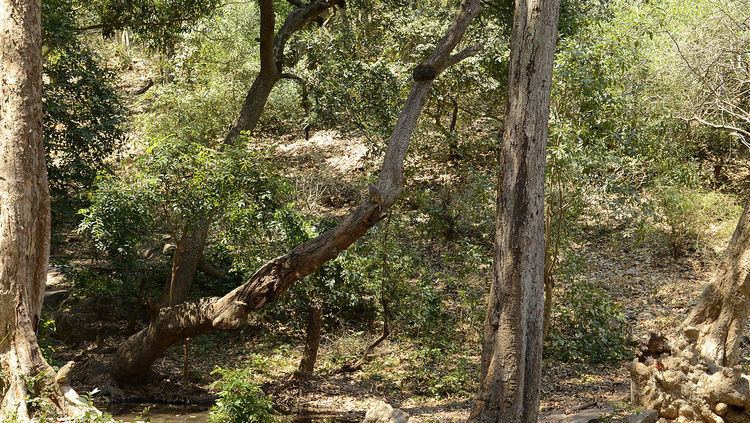 | ||
The Central Deccan Plateau dry deciduous forests is a large Tropical dry broadleaf forest ecoregion of southern India, containing large protected areas of natural habitat of the tiger.
Contents
Setting
The Deccan Plateau is a large triangular plateau in southern India, bounded by the Western Ghats range to the west, the Eastern Ghats to the east, and the western Satpura Range to the north. The Central Deccan Plateau dry deciduous forests occupy an area of 240,200 square kilometers (92,700 sq mi), in which the dominant natural habitat is or was woodland of Hardwickia binata and Albizia amara trees, located on the central and southern portion of the plateau. The ecoregion lies mostly within the states of Maharashtra and Telangana, extending into adjacent parts of Madhya Pradesh, Chhattisgarh, and Andhra Pradesh. In Maharashtra, the Central Deccan Plateau dry deciduous forests cover most of the Vidarbha region, including the city of Nagpur. In Telangana, the dry deciduous forests cover much of the state, including Hyderabad, the state capital, with a small portion extending across the Eastern Ghats to the Bay of Bengal in Krishna District of Andhra Pradesh.
The xeric Deccan thorn scrub forests lie to the west, south, and southeast, covering the drier portions of the plateau in the rain shadow of the Western Ghats. The more humid Eastern Highlands moist deciduous forests lie to the northeast and east, while the Narmada Valley dry deciduous forests lie across the Satpuras to the northwest.
The Godavari River crosses the ecoregion from its source in the Western Ghats and indeed most of the rivers on the plateau drain east towards the Bay of Bengal, with the exception of the Tapti River in the northwestern corner of the plateau, which drains westward into the Arabian Sea.
This is a highly populated area and most of the natural forest in the ecoregion has been cleared for firewood or grazing land or as a result of river damming, all of which are ongoing. However large blocks of original habitat such as the Nagarjunsagar-Srisailam Tiger Reserve in Telangana and Andhra Pradesh do remain.
Flora
Woodlands of Hardwickia binata and Albizia amara are the characteristic plant community of this ecoregion, distinguishing it from the predominantly teak (Tectona grandis) or sal (Shorea robusta) woodlands found elsewhere in the Deccan. The Central Deccan forests have an upper canopy at 15-25 meters, and an understory at 10-15 meters, with little undergrowth. The Hardwickia trees lose their leaves during the winter dry season, and leaf out again in April. Other tree species in the northern part of the ecoregion include teak, Boswellia serrata, Lannea coromandelica, Anogeissus latifolia, Albizia lebbeck, Lagerstroemia parvifolia, Diospyros tomentosa, and Acacia catechu.
Fauna
The large areas of remaining forest on the plateau are still home to a variety of grazing animals from the four-horned antelope (Tetracerus quadricornis), chinkara (Gazella bennettii), and blackbuck (Antilope cervicapra) to the large gaur and wild water buffalo (Bubalus arnee). Large carnivores include tigers (Panthera tigris), the dhole (wild dog, Cuon alpinus), and sloth bear (Melursus ursinus). The area is home to nearly ninety mammal species. Some of the larger species mentioned here are rare, as is the threatened Indian giant squirrel (Ratufa indica). The 300 species of birds include the globally threatened Jerdon's courser (Rhinoptilus bitorquatus), which was rediscovered in 1986 having been thought extinct for nearly a hundred years.
Conservation
About 80 percent of the natural habitat in the ecoregion has been lost. Several blocks of habitat larger than 5,000 km2 remain. Fifteen protected areas cover almost 3% of the ecoregion's area, with Nagarjunsagar-Srisailam Tiger Reserve as the largest.
